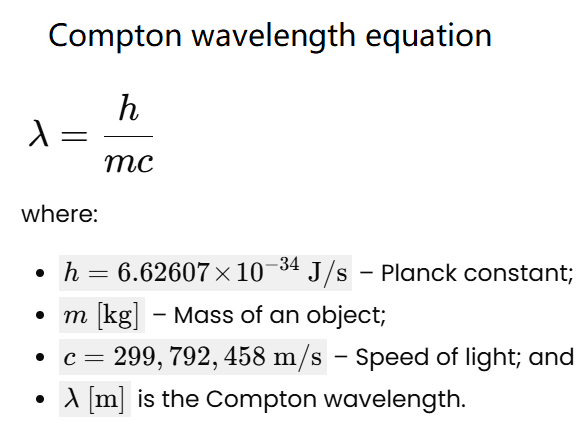Compton Wavelength Calculator
Compton Wavelength Explanation
The Compton wavelength is a fundamental concept in physics that describes the relationship between the quantum wave nature of a particle and its rest mass. It gives the wavelength of a photon whose energy is equal to the rest energy of the particle. The formula for Compton wavelength is:
λ = h / (m * c)
Where:
- h = Planck's constant (6.62607015 × 10-34 J·s)
- m = Mass of the object
- c = Speed of light (299,792,458 m/s)
The Compton wavelength λ describes a length scale associated with the quantum properties of a particle. It essentially marks the boundary between classical and quantum descriptions of the particle's behavior.
Physical Significance
The Compton wavelength has several important interpretations in physics:
- Wave Nature of Particles: The Compton wavelength corresponds to the characteristic "wave-like" behavior of a particle. For particles with smaller mass, their Compton wavelength is larger, which makes quantum effects more noticeable. On the other hand, for larger mass particles, the Compton wavelength is smaller, and quantum effects become less significant.
- Energy and Momentum: The Compton wavelength also relates to the particle's energy and momentum. For instance, when a particle interacts with light (photons), its Compton wavelength plays a significant role in the resulting energy transfer, such as in Compton scattering.
- Quantum-Classical Boundary: The Compton wavelength is the threshold at which quantum mechanical effects dominate. If the particle's wavelength is larger than its Compton wavelength, quantum effects become apparent. For particles with much smaller wavelengths, classical mechanics is sufficient.
Compton Effect (Compton Scattering)
The Compton Effect refers to the scattering of high-energy photons (like X-rays or gamma rays) by electrons. The photon’s wavelength changes as a result of this interaction, and the shift is directly related to the electron's Compton wavelength. This phenomenon, discovered by Arthur Compton in 1923, demonstrates the quantum nature of light and matter.
Example: Compton Wavelength of an Electron
For an electron, the rest mass is approximately:
mₑ = 9.10938356 × 10-31 kg
The Compton wavelength for an electron can be calculated using the formula:
λ = h / (mₑ * c)
Substituting the known values:
λ = (6.62607015 × 10-34) / (9.10938356 × 10-31 * 299792458) ≈ 2.426 × 10-12 meters (or 2.426 femtometers)
This value corresponds to the typical scale of electron quantum effects, and it's about 2.426 femtometers (fm). This is a very small distance, much smaller than everyday scales, but critical in particle physics and quantum field theory.
Applications of Compton Wavelength
The Compton wavelength has several important applications in modern physics:
- High-Energy Physics: In particle accelerators, Compton wavelength is used to understand the interactions between high-energy electrons and photons, especially in scattering processes.
- Quantum Field Theory: The Compton wavelength helps in understanding the quantum nature of particles and the interactions between particles and fields.
- Astrophysics: In extreme environments, such as near black holes or neutron stars, the Compton wavelength plays a key role in understanding the behavior of particles in strong gravitational fields.
Compton Wavelength Calculator© - All Rights Reserved 2024
 Home
Home
 Back
Back
